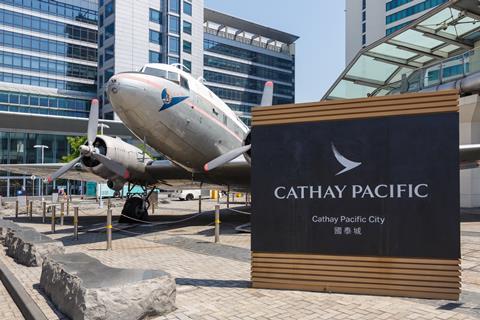Cathay Pacific’s sustainability chief is hopeful of “more ambition” in targets set for sustainable aviation fuels, amid wider discussion over the sector can boost its sustainability credentials.
Grace Cheung is the Hong Kong-based carrier’s general manager for sustainability and is working – among other things – to meet Cathay’s target of 10% SAF usage by 2030. The airline in 2021 set the target as it works towards its target of net-zero emissions by 2050.

Cheung acknowledges that the target is “ambitious”, but not impossible, though it would require “the whole value chain” to work together.
She was speaking to FlightGlobal on the sidelines of the recent Singapore air show, where she was also involved in a panel discussion on sustainability.
Cathay in late-January joined 12 other partners – including a Hong Kong-based business group and fuel suppliers – to form a coalition looking into the development and adoption of SAF.
“We are fully aware that Cathay alone will not be able to make it happen…so we are really aware that…the whole value chain [must] work together,” says Cheung.
The airline is one of the two co-initiators of the coalition, whose other members include the Airport Authority of Hong Kong, Shell Aviation, China Aviation Oil (Hong Kong), Standard Chartered Bank, as well as the Hong Kong Business Environment Council.
“While there is a lot of development in the USA and in Europe, we need to localise production and the supply chain for us to meet the 2050 goals [of net-zero carbon emissions]. For a SAF supply chain to really take off, you not only need the airline, but you also need the suppliers to come together; you need the right policy support,” Cheung says.
The coalition’s formation came as the city’s government signalled its intentions to “drive the use of SAF”.
Like Hong Kong, Singapore has also rolled out its own measures to drive SAF usage.
The city-state has just announced it would be imposing a levy on all outbound travellers from 2026, becoming one of the first countries in the world to do so. Singapore aims for all departing flights to use at least 1% SAF from 2026, with the amount rising to around 3-5% by 2030.
”While there is a lot of development in the USA and in Europe, we need to localise production and the supply chain for us to meet the 2050 goals”
Cheung believes this is a “clever” move: “It sends a very clear message to the supply chain that [the Singapore government] will be making use of SAF, so go ahead and invest in it. The levy is smart as it does not penalise any airline willing to use SAF as it is applicable to all airlines flying out of Singapore…this addresses the ‘level playing field’ concerns.”
Cheung was referring to concerns of varying SAF usage commitments among airlines: Cathay for instance commits to 10% SAF usage, while other carriers may have lower targets.
Still, Cheung says that beyond a “SAF levy”, more can be done to increase usage of the fuel.
“We hope that with the successful roll-out [of the levy], the [SAF usage target] can be increased further, because we know that even 5% of SAF usage is not enough yet to meet the Paris Agreement’s aim [of limiting global temperature increases],” she says.

HONG KONG LEADERSHIP
Back to Hong Kong, Cheung believes the city “can show sustainability leadership”, given its status as an international hub.
“We have many international airlines from the USA and Europe operating into Hong Kong that have set [similar SAF usage goals]. So there is not just one airline asking for [SAF], but actually there is industry demand,” she adds.
Hong Kong, as an aviation hub, can “enable more airlines” to operate sustainably, including promoting and facilitating the use of SAF.
However, Cheung is also aware of the challenges confronting the fledgling sector.
She notes that Hong Kong - like Singapore - is much smaller than most major economies,
“There will never be enough resources…locally to produce the level of SAF that a leading aviation hub requires. The challenge for Hong Kong is - how do we work with nearby countries or regions [to scale up SAF production]?” says Cheung.
That the technology for SAF production is still relatively new is also a challenge, as it would take more time to properly and safely scale up.
The clock is ticking, and as Cathay hopes to meet its green targets, Cheung says the airline has gone some way in its “front-facing” sustainability efforts, like waste reduction for instance.
Single-use plastics have been removed, as have straws. The airline replaced its economy class cutlery set with one made of lightweight reusable metal, while drink cups are now paper.
“Even if our customers are not aware of climate change impact or what we have been doing, we can engage them with what they can see or touch with the reduction of plastics…it is our way to engage a wider audience,” she adds.


